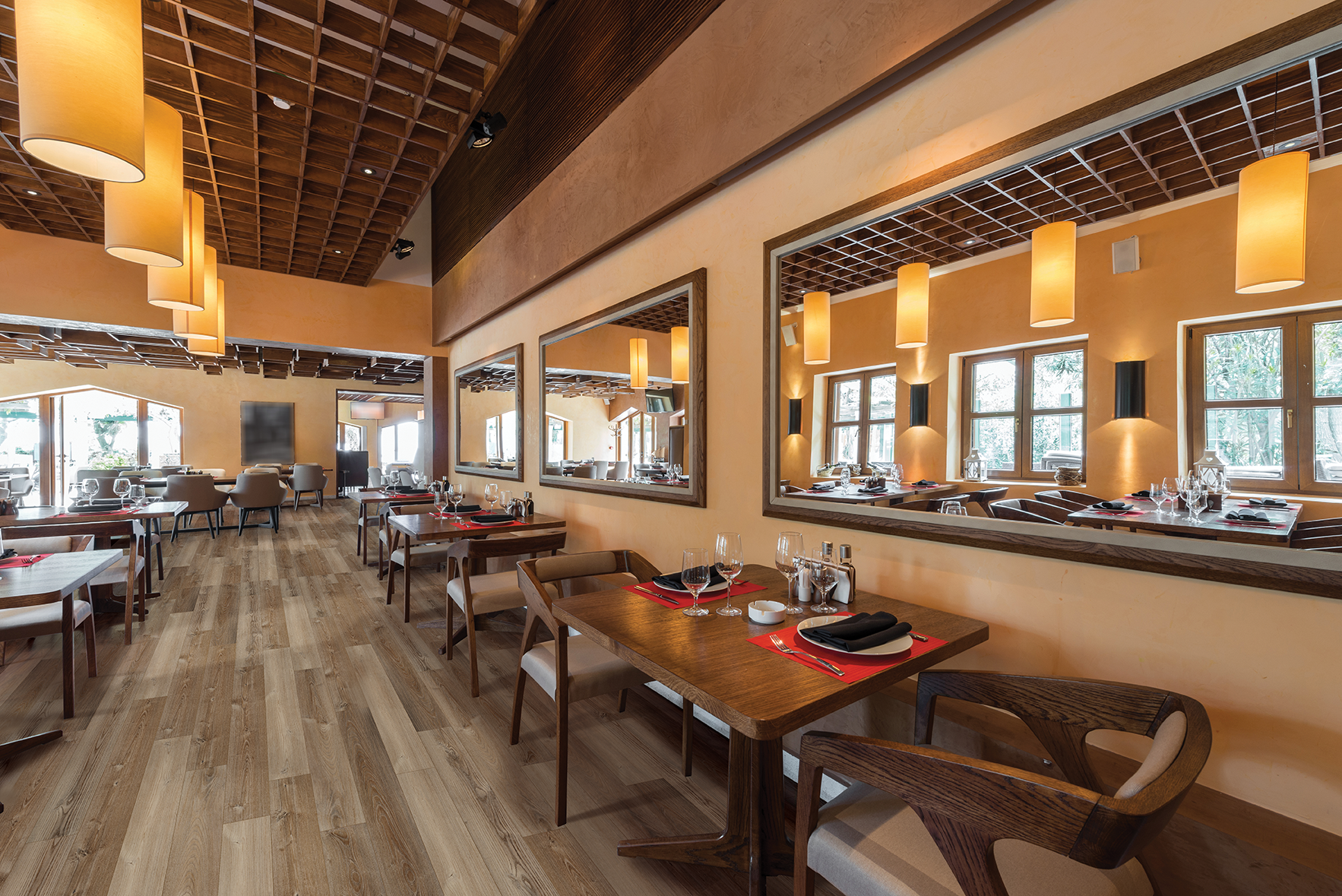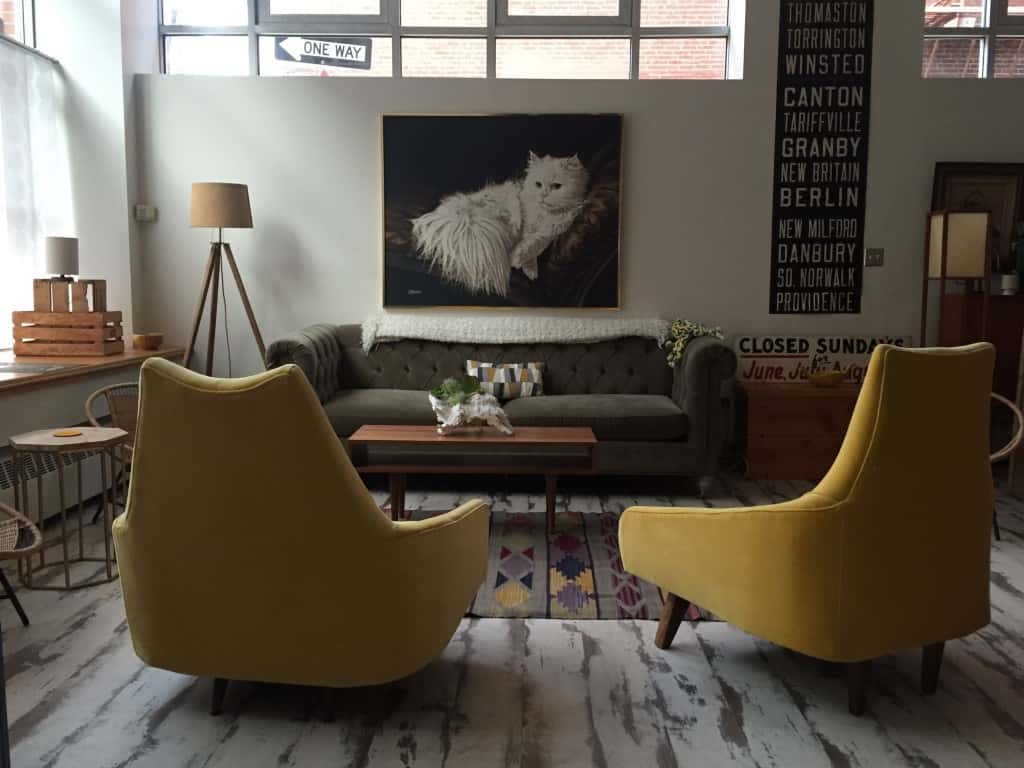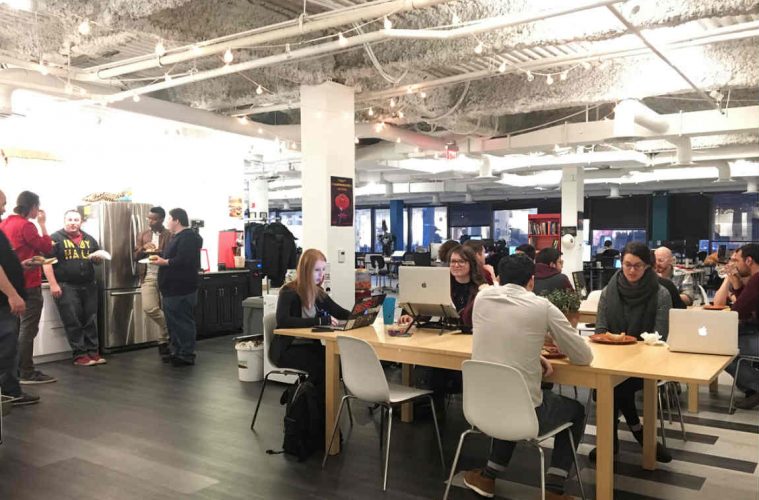When you imagine a coworking space - or any modern office space - there are a few visual and aesthetic trends that typically come to mind.
Those mental images are reinforced in what shows up when you do a Google Image Search for coworking, too.
- High ceilings with exposed industrial features
- Exposed brick
- Funky, modern lighting
- Bright colors
- Wacky chairs
But the most common visual “feature” might be one you don’t even notice at first.
Polished concrete floors.
Apart from wood and (gasp) carpet, polished concrete is one of the most aesthetically repetitive design choices in coworking and modern workspace design in general.
Back in the early days of coworking where people were scrapping together whatever space we could afford to gather our communities, older industrial spaces were less less desirable and so often less expensive.
Those “raw” industrial features weren’t an aesthetic choice. Like naturally occurring bed-head, we just woke up looking that way.
But like bed head became an aesthetic (complete with expensive waxy hair-goop to preserve the look throughout the day), so did polished concrete become a staple of modern workspaces.
Unfortunately, polished concrete is the god-damned devil
Yes, polished concrete can look really cool. That post-industrial-chic look shows up super-sexy in Instagram photos and magazine spreads.
But polished concrete is one of those things that is more of a first impression than something anybody will enjoy living with.
Wanna know how I know?
Because Indy Hall had polished concrete floors for over 7 years.
No doubt, our previous space was iconic. Warehouse-y and industrial in all of the ways you think of when you think “creative space.” It was a pirate ship for creative independents in every way.
So we had an interesting challenge when we moved in 2016 and our new space was in a more modern office building complete with drop ceiling and carpet tile floors. Ew.
Of course, we ripped all of that out. And besides lighting, the flooring presented the biggest opportunity to improve.
Originally the architects proposed we polish the concrete floor that had been hidden under those filthy carpet tiles. “That’s what all of the modern office tenants want!” they said.
Any time something becomes a default, I question it. And I started doing my research.
The more I learned, the more angry I got that we’d been living with polished concrete floors for 3/4 of a decade.
Here are 6 reasons I found out that polished concrete is one of the worst materials you can choose to use in your coworking space.
1. It’s an acoustic nightmare.
Polished concrete basically turns every inch of flooring in your coworking space into the acoustic equivalent of pane glass.
Which means, in any kind of shared space, polished concrete is about the worst material choice you can make.
Even unpolished concrete is a bit better than polished.
In addition to making your space into an echo chamber, you’re going to spend even more money compensating for it with any number of ridiculously expensive “fixes” none of which really completely correct for the acoustic damage done by the concrete.
Thinking “what about rugs? that’s a cheap way to cover up the concrete!” Yes, rugs can create a fractional improvement but…be prepared for those rugs to wear out and fray faster than anything you’ve ever seen. Nothing beats up a rug faster than daily foot traffic grinding the fibers against poured concrete.
2. Murder on joints
I didn’t even really notice how true this was until I had a side-by-side comparison while we were moving.
If I spent the first half of my day on my feet our old space (with concrete floors) and the 2nd half of the day at the new space (without them), my ankles and knee would be agonizingly sore by mid-day.
But if I flipped it around and spent the morning walking around on friendlier flooring, and then the afternoon on concrete, the pain was barely noticeable at all.
3. Slippery when wet
Dangerously slippery.
All it took was a tiny splash of coffee or water, or even a bit of moisture after mopping up a spill, and that wet patch of concrete turned into a death trap.
Thankfully nobody was seriously hurt, but plenty of people (including myself) were sent ice-skating by an invisible hazard.
4. Mean to anyone in heels
Besides the increased slipping hazard for anyone wearing heels, polished concrete makes anyone wearing heels sound like a heavy-footed monster.
It was surprisingly common to hear people complain that they felt awkward wearing their heels - something they liked wearing to work! - because the floors made it impossible for them to walk quietly.
5. Self-dirtying
Floors are gonna get dirty in your coworking space. It’s just gonna happen.
But our floors were constantly getting dirtied by the floors themselves as the daily wear and tear of the floor generated an incredible amount of dust.
We even rented professional cleaning equipment, which made the floors look AMAZING for a few months until the dust started to build up again.
6. It parades as cheaper. But it’s not!
This blew me away.
When our architects suggested polished concrete and I started looking at alternatives, I also started comparing prices. And polishing concrete is EXPENSIVE.
Depending on the condition of the concrete (and your local labor costs), it’s easy to spend $4 to $5 per square foot.
Even if you end up spending a bit more per square foot on materials and labor, you won’t waste time and money later trying to fix the inherent brokenness of polished concrete.
So, what’s better than polished concrete?
Anything. 😂
But seriously, based on my research, the BEST flooring options are actually a certain category of industrial laminate.
Now…I know what you’re thinking. “Is there anything less cool looking than laminate?” That was what I thought when it was first suggested as an alternative.
Like most people, the only exposure I’ve had to laminate floors are the janky, yellowed plastic stuff in the kitchens and bathrooms of my grandparents’ house.
But these days, laminate has come a LONG way.
Like, can you believe that this isn’t a hardwood floor? Yup, laminate.

Credit where credit is due, my first introduction to this kind of product was from my business partner Amy Hoy. She has incredible taste and is a research monster, so when she and her husband were redesigning an office around the corner from Indy Hall I fell in love with a flooring choice she made (I can’t believe I just wrote that sentence either).
But seriously, look at this.

That whitewashed cabin/beach house look is an incredibly durable, fast-installing, completely waterproof laminate product. Amazing, right?
Flash forward to 2016 when I’m about to spend tens of thousands of dollars on the floor of Indy Hall’s new space, and I started looking for similar options for our space.
I started reading more and more about a particular line of laminate flooring from a company called CoreTec. Specifically, I was reading was how absolutely incredible it was at dampening and controlling sound, which was one of our top goals for the new space.
Turns out, the magic sound-dampening properties of this flooring are thanks to a bonded to a layer of cork backing.
With this floor, every single square inch of flooring contributed to positive acoustic properties: echos are absorbed and sound travel is limited.
According to the marketing, that reduction could be as much as 62 decibels!
The cork backing even makes these floors squishier to walk on. Not squishy in a weird way, but just a slight amount of give with each step.
Basically, I found flooring that was the complete opposite of polished concrete.
On top of that, it looks great! We picked a color and style that shows up as a cool grey wood texture (almost like pickled wood), with very subtle red/brown lowlights.
How fancy do I sound talking about my floors. But seriously, I’ve never gotten so many unprompted compliments on flooring in my entire life.

In the kitchen, we chose a darker color from the same product line to visually designate the kitchen as a “special” area, and I had the idea to make it look like the edge was “woven.”

Truth be told, I was super skeptical about the heavily marketed acoustic properties of this flooring. But I was here the day they installed it.
I got to see - rather to hear and feel - the drastic difference in the way sound moved through the space between areas that still had exposed concrete and areas that had this magical laminate product installed.
It was night and day. I can’t describe it any other way.
Most incredibly is how it impacts the way sound travels day to day.
If our current space had the same acoustic properties of our old one (with the concrete floors) it would be unusable. Full stop.
And yet, this is exactly what most people experience every day in their coworking space. Shiny floors that turn every room into an echo chamber. Glossy glass walled offices that both reflect and transmit sound. Literally the worst.
All because somebody decided that the “cool default office design” should be polished concrete floors. Just say no to accepting office design “defaults” and just say no to polished concrete floors.
But Alex, what if my space already has polished concrete floors?
Well, my friends, we had polished concrete floors for seven years.
In those seven years we more than tripled the size of our community and expanded our footprint twice in the same building.
Floors aren’t going to be the thing that makes or breaks your success. Ever.
Remember, I’m talking about decisions we made in is our third location, not our first location. We’ve been successful in spite of our shitty concrete floors for an entire decade before we even had a chance to make these kinds of decisions.
So when we did have a chance, I wanted to get it right.
And maybe when you relocate or expand or are looking to invest in a long-term upgrade in your space, these lessons can help you!
Realtalk, though? I still don’t give a shit about flooring in spite of having just written 1600+ words about it.
But I do care about doing the best job I can, with the stuff I’ve got.
 I am always thinking about the intersection of people, relationships, trust and business. I founded
I am always thinking about the intersection of people, relationships, trust and business. I founded